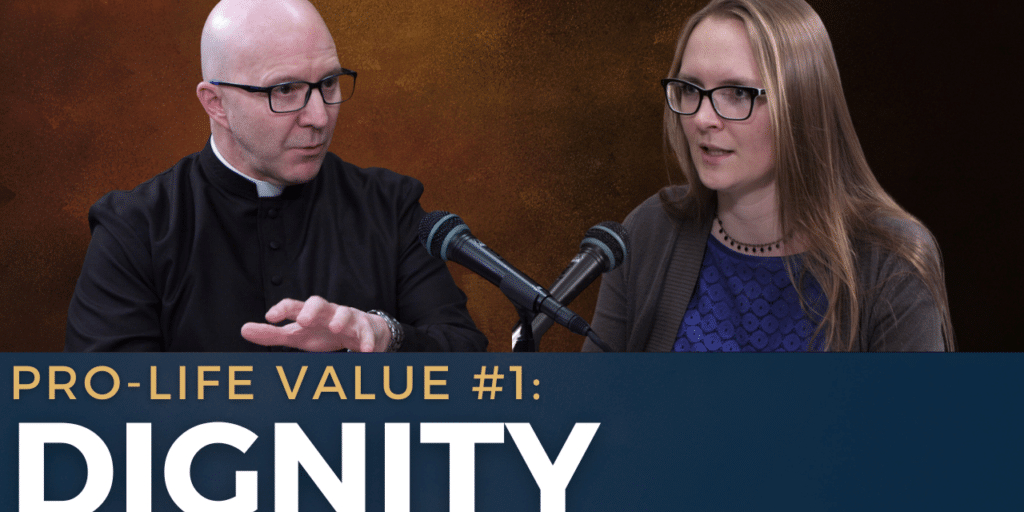We Don’t Need Abortion to Save Mom’s Life
With Roe gone and abortion already illegal, or set to become illegal, in numerous states, you can expect abortion activists and pro-abortion media to go into overdrive spreading propaganda, trying to make the case that abortion is often “necessary” to preserve the life or health of the mother.
By now, we know the tactics all too well. Abortion activists highlight the most extreme and rarest cases to gin up public support for legalization. And then once abortion is legal, they completely ignore the fact that over 99% of abortions taking place have nothing to do with the extreme cases that were used to achieve legalization in the first place.
Instead of cynically using the suffering of the women in these hard cases as a wedge to achieve social and cultural transformation, pro-abortion propagandists would be better served in pursuing a model of health care that values and prioritizes both patients in a pregnancy — the mother and her unborn child — as pro-life doctors have been doing for decades with great success.
Prioritizing Both Lives
The fact is, as many pro-life OB/GYNs and other doctors with decades of experience have made clear, abortion is never medically necessary. And it’s not health care.
It is true that in pregnancy complications can arise — e.g., gestational diabetes, pre-eclampsia, problems with the placenta, and heart problems. As the National Catholic Bioethics Center writes, “Pulmonary hypertension, for example, is often exacerbated by pregnancy: the additional blood volume of the pregnancy burdens the mother’s weakened heart and, in extreme cases, can result in heart failure and the death of both mother and child.”
However, in such circumstances, doctors who appreciate and respect the value of the lives of both the mother and child will first pursue medical strategies that take into account the life and health of both patients, often with the result that both mother and child safely come through the pregnancy, to the great joy and satisfaction of everyone involved.
Last week I discussed the idea that legal abortion has created legal, social, and economic structures that positively incentivize abortion, making it more difficult for mothers who want to give birth. I should also have included in that list “medical” structures. This is because in a society where abortion is legal, doctors and health care workers are incentivized to take the “easy” way out any time they encounter a difficult situation, immediately counseling abortion, even in cases where it might well be possible to save the life and health of both the mother and child.
In some cases, the motivation for counseling an abortion can be as callous as a concern over legal liability. Should the doctors take even a mild “risk” by searching for solutions to care for both patients, there is the worry that they might be sued if something should go wrong. However, the motivation can also come from uncertainty about how to deal with such a case, due to a lack of training or reliable medical data about likely outcomes.
In a healthy society, our medical system would instead incentivize doctors (health care workers) to pioneer and pursue creative solutions that lead to better outcomes for mother and child. Instead, we too often immediately reach for abortion, robbing many women of the opportunity to safely give birth, and instead burdening them with a lifetime of regret.
Even some pro-abortion doctors admit that the idea that abortion is necessary to save the life of the mother is not true, and that advances in medical treatments mean that doctors now can almost always take care of both mother and child. As one abortionist, Don Sloan, put it:
If a woman with a serious illness – heart disease, say, or diabetes – gets pregnant, the abortion procedure may be as dangerous for her as going through pregnancy … with diseases like lupus, multiple sclerosis, even breast cancer, the chance that pregnancy will make the disease worse is no greater that the chance that the disease will either stay the same or improve. And medical technology has advanced to a point where even women with diabetes and kidney disease can be seen through a pregnancy safely by a doctor who knows what he’s doing. We’ve come a long way since my mother’s time….
The idea of abortion to save the mothers’ life is something that people cling to because it sounds noble and pure – but medically speaking, it probably doesn’t exist. It’s a real stretch of our thinking.
Indeed, even despite the existence of legal abortion, many advances in health care have taken place in recent years, and we now know that in cases where abortion was thought to be necessary in the past (of course, it should never have been considered an option), in fact continuing the pregnancy often results in positive outcomes. One small study published in 2010, for instance, found that every woman in the study with pulmonary hypertension that continued the pregnancy safely gave birth.
There are also a growing number of cases of women suffering from cancer who have been able to receive treatment for their cancer and still to safely care for their unborn children. This is due to the creative efforts of certain doctors who have refused to accept that they must sacrifice one patient for the other.
The Principle of Double Effect
There are cases that arise, however, in which even the most pro-life of doctors cannot find a way to preserve the life and health of both the unborn child and his or her mother. In cases like these, doctors and the parents of the child may have to make difficult decisions. However, these decisions must still be guided by clear moral principles, in particular that the direct killing of innocent life is never permissible.
In the United States, the U.S. Catholic Bishops Conference has produced a document called the Ethical and Religious Directives (ERDs). This document provides guidelines for Catholic health care workers on how to navigate difficult medical situations in ways that respect the moral law.
The Ethical and Religious Directives make it clear, “Abortion (that is, the directly intended termination of pregnancy before viability or the directly intended destruction of a viable fetus) is never permitted. Every procedure whose sole immediate effect is the termination of pregnancy before viability is an abortion, which, in its moral context, includes the interval between conception and implantation of the embryo” (no. 45).
In other words, we may never, under any circumstance, directly take the life of an innocent human being.
However, this does not mean that doctors must be indifferent in cases when medical situations arise during pregnancy that legitimately threaten the life of the mother. In these cases, creative strategies founded upon a profound respect for the dignity and value of the mother and child, as well as a realistic assessment of the situation, can be pursued.
Catholic teaching is clear that in some cases we may tolerate the indirect and unintended loss of life that comes when trying to address a life-threatening medical situation, e.g., an ectopic pregnancy (“tubal” pregnancy), a cancerous uterus, etc., when other alternatives are not available and provided certain conditions are met.
This is known as the “principle of double effect.” In general terms, this principle states that at times it may be permissible to perform a morally good or neutral action that brings about a good result, even if it indirectly brings about a foreseen and undesirable side-effect (a secondary, unintended effect). Perhaps the most paradigmatic case of this principle in action is when doctors remove the fallopian tube of a woman in the case of an ectopic pregnancy (i.e., when the embryo has implanted in the fallopian tube, which is a life-threatening condition for both mother and child). In such a situation, the section of fallopian tube around the growing child has become pathological and constitutes an increasing threat to both mother and child. Ideally, the embryo would be surgically removed from the fallopian tube and safely transplanted to the uterus, but this procedure is not yet a viable option. Therefore, the threat is addressed by removal of the fallopian tube with the unintended, secondary effect being that the child within the tube will not survive.
The intention of the doctor (surgeon) is directed towards the good effect (addressing the pathology by removing the damaged tissue to save the mother’s life) while only tolerating the bad effect, which is the unintended death of the child. The surgeon is choosing to act directly on the fallopian tube, which is a part of the mother’s body, rather than directly on the child. The child’s death is not the means by which the cure of the mother occurs; it is by the act of removing the fallopian tube, not the subsequent death of the child, that the curative result is accomplished for the mother’s medical condition. Though the death of the child is foreseeable, it is not the intended or desired outcome of the medical intervention which saves the life of the mother.
As the ERDs state, “Operations, treatments, and medications that have as their direct purpose the cure of a proportionately serious pathological condition of a pregnant woman are permitted when they cannot be safely postponed until the unborn child is viable, even if they will result in the death of the unborn child” (no. 47).
In some cases, it is worth noting, mothers have heroically chosen to give up their lives in order to ensure that their unborn babies are able to live. I know of several cases of women who have chosen to forego treatment for cancer, for instance, due to the risk that the treatment would seriously harm or kill their unborn child. In fact, in 2004 Pope St. John Paul II canonized Gianna Beretta Molla, an Italian doctor and mother who refused both an abortion and a life-saving hysterectomy in order to successfully save the life of her unborn child.
This heroic choice is an option that our pro-abortion culture often doesn’t even consider. However, my hope would be that in a pro-life culture, we would pour resources into finding treatments that would make such a difficult choice unnecessary.
Combatting Pro-Abortion Confusion
Despite the fact that the Catholic Church and pro-life ethicists have developed sophisticated and morally sound medical and ethical principles for dealing with various “hard cases,” pro-abortion media and organizations continue to muddy the waters by insisting that abortion is medically necessary, and that without legal abortion women will die.
For instance, many pro-abortion propagandists continue to insist that making abortion illegal will also make illegal treatments for such conditions as ectopic pregnancies. However, as Jonathan Turley pointed out in a piece for Fox News a few days ago, not only is this a lie, but it is also a dangerous lie. As he noted, even in states where abortion is illegal, there are provisions for treatments for ectopic pregnancy, even if they result in the death of the child. Oklahoma’s law, for example, clearly states, “An act is not an abortion if the act is performed with the purpose to… remove an ectopic pregnancy.”
As Dr. Christina Francis, a board member of the American Association of Pro-Life Obstetricians and Gynecologists, told the Catholic Register recently, “treating an ectopic pregnancy is not an abortion; it is a procedure to save a woman’s life.”
Father Tad Pacholczyk, director of education at the National Catholic Bioethics Center, told the Register, “It’s a great urban myth that banning elective abortions will decrease access to appropriate care for mothers.”
As a Catholic hospital treats and cares for both the mother and her unborn child, it remains committed never to crossing an important line: It may not directly take the life of an innocent human being as it cares for both patients. Catholic hospitals, nonetheless, are able to provide appropriate medical treatments that may result in the indirect loss of unborn life, tolerating that unintended loss when other alternatives are not available. Those admitted to Catholic health care institutions know one indisputable fact: They and their children will be treated using the highest standards of medical care, even as they remain safe from a direct assault upon either of their lives.
Indeed, as Catholics we can be proud that we hold true to fundamental moral principles that will build a more humane society. To directly kill an innocent human being, even in the hopes of saving the mother, is to intentionally engage in an intrinsic evil, even if good may follow. And as experience shows, it is also medically unnecessary. As the NCBC notes, “By always repudiating the direct killing of the innocent…we set in place the framework to safeguard human dignity at its root,” in the understanding that every life is of incomparable value from the moment of conception.
As president of Human Life International, Fr. Boquet is a leading expert on the international pro-life and family movement, having journeyed to nearly 90 countries on pro-life missions over the last decade. Father Boquet works with pro-life and family leaders in 116 counties that partner with HLI to proclaim and advance the Gospel of Life. Read his full bio here.









Many thanks, Father, for your elucidation especially with regard to ectopic pregnancy.
We need to understand that this is a life-threatening situation for both mother and unborn child and that the death of the unborn is an unfortunate but unavoidable consequence. However, “well-intended”, the deliberate and calculated intention to end the life of the unborn can never be morally justified.
I am very concerned about the direction of America when I watch pro-abortion women and men protesting with their young children right there with them holding signs and yelling out phrases. And I have seen it in my city, Wichita, Kansas as we are about to vote on putting abortion laws back in the hands of our citizens. We need a unanimous victory in this vote in order to send a message to the pro-abortion supporters that the majority of our citizens believe abortion is an atrocity. It is hard to argue against a large majority vote for the right to the life of the unborn. Please pray for our state to gain this victory.
You are obviously an educated man with great connections as well as access to a wealth of information.
I do know that in times past, before the days of birth control, parents had many children. Before the age of pharmaceuticals, many of those children died before reaching adulthood and those who reached the stage of adults were scarred for life. Pharmaceuticals have changed life for everyone. Pharmaceuticals have improved the quality of life for everyone. Those pharmaceuticals include birth control.
To link birth control with abortion is wrong thinking. If anything, birth control is good family planning. To link birth control with lack of respect for human life is wrong thinking. Lack of respect is authorities who have no experience, who foist their opinions upon the lives of others who know the difference but are trusting said authority to speak the truth. Authorities instilling guilt into the lives of people based on their choice to exercise birth control is wrong thinking. I do know the control that authorities who claim all power, exercise upon those they want to influence.
I also know that a man of the cloth such as yourself, has been steeped in the traditional Roman Catholic dogma. Your set of beliefs are contrary to the finished work of Jesus Christ on the cross, who died for our unbelief and set us free from sin and belief. Colossians 1 : 22 says that we have been found holy and unblameable and unreproveable in his sight. Verse 23 That we may continue in ( God’s ) faith grounded and settled…….
The gospel of peace has set us free as is found in Isaiah 54: 9 and 10.
I read your article. I have a question and hope you can provide some insight into this grave matter.The rate of maternal mortality in African American Women is twice as that of White Women and 3 times the number of Hispanic Women. I’m sure some African American women have been advised of this and given abortion as a option. What would you say regarding this concern.
Thank you for the question, Elaine. There are many reasons that both the abortion rate and the maternal mortality rates among Black women are so high. They include low marriage rate, which leads to more abortions; poor diet; high domestic violence rates; a very high rate of illegal drug use; poor levels of prenatal care (in fact, ER physicians will note that the first prenatal care some Black women received is when they appear at and emergency rooms in the middle of labor to deliver a baby).
The practice of high abortion among Black women has always been explicitly encouraged by the pro-abortion movement, to the point where pro-abortionists locate their abortion clinics disproportionately in minority neighborhoods and even condemn pro-life efforts to try to save preborn Black children. So, in our upside-down world, the people who kill Black children are heroes and the people who try to SAVE Black children are “racists.”
The solution to this problem will take many years to implement even if the political will to do so is present. This would involve a complete overhaul of certain aspects of the Black community that no politician will dare to touch for fear of being labeled a racist. These include a reconstruction of the Black family norm where the father of the children stays home and a systematic crackdown on the pervasive and violent drug and thug cultures.